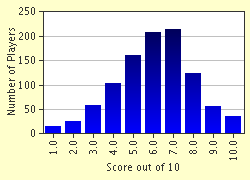Quiz Answer Key and Fun Facts
1. According to Wien's Displacement Law of blackbody radiation, the "colour" of a star is related directly to its surface temperature. In general, red stars are cool while blue stars are hot. Which of the following stars is the coolest?
2. How would an aqueous solution of an acid, made dilute enough to not burn your tongue and/or alimentary canal, taste?
3. A blacksmith has a block of iron which he wants to inhibit the rusting of as far as possible. He decides to mould the iron block into a solid that leaves the iron exposed as little as possible to air. Which of the following solids would offer the least surface area for rust to form?
4. Where in the human body would you find erythrocytes, leucocytes and platelets?
5. The tricarboxylic acid cycle, or Krebs Cycle, named after Sir Hans Adolf Krebs (1900-1981), is a series of chemical reactions of utmost importance in the oxidation of glucose for the release of energy in aerobically respiring organisms - including ourselves! This cycle is also named after a certain organic acid, which is an important intermediate in this series of reactions - which is it?
6. General Sherman, one of the world's largest living organisms (in terms of volume) at the beginning of the 21st century, is which of these?
7. Viscosity is a measure of the resistance of a fluid to deformation under shear stress, or simply put, its resistance to flowing. At room temperature, which of the following is the MOST viscous?
8. An oxidising agent is a substance that "oxidises" another substance, i.e. takes electrons from it, and in doing so, itself gets "reduced" or accepts electrons. Which of the following substances is a good oxidising agent?
9. Scurvy is a disease which results from the lack of a certain vitamin, also called "ascorbic acid", in a person's diet. Which is it?
10. So how are all these answers related; what's the "common bond"?
Source: Author
achernar
This quiz was reviewed by FunTrivia editor
crisw before going online.
Any errors found in FunTrivia content are routinely corrected through our feedback system.

